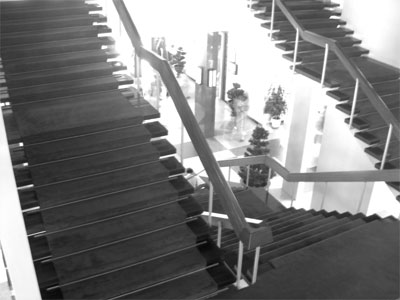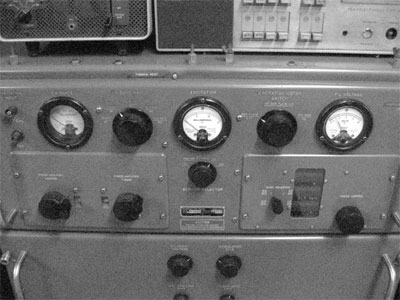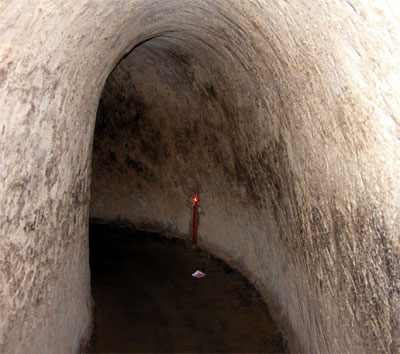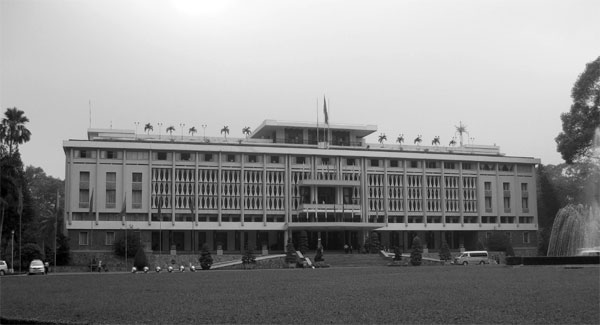On the Reunification Palace, the War and the End of 2010
No one building symbolizes the war more than the Reunification Palace. If I ask you, the reader, to look within and draw up images of Vietnam, then one of them will surely be a North Vietnamese tank crashing through the gates of what was then the Independence Palace, the seat of government of South Vietnam. This is where Saigon fell and where the war ended; and with it, America's myth of its own invincibility.
The palace we see today is actually the third palace to have stood on this spot; the first having burned to the ground in the French Cochinchina period and the second having been bombed by renegade elements of South Vietnam's own air force in 1962. It is not a good sign if you are being bombed by your own air force and it could hardly have augured well for the war. Indeed, one cannot help but contrast the need of southern leaders to live in regal palaces and Uncle Ho's stilted peasant house in the centre of Hanoi.
The modernist masterpiece we see today was the brainchild of Ngo Viet Thu, who was educated in Paris at Les Ecole des Beaux-Arts and was also the winner of the prestigious Grand Prix de Rome. His creation is the most stunning example of 1960's architecture I have ever seen.
The very term '1960's architecture' conjures up monstrous images in the mind of asbestos-laden tower blocks, grey as death, in a never-ending Leggoland nightmare. We picture urban decay in housing projects where the sun never shines -- the Corbusier Cauchemer of the Council Estate. We picture all kinds of hells unknown to Adam, but the Reunification Palace shows us that it does not have to be this way. Modernist architecture can be beautiful! I swear it -- I have seen the New Jerusalem.

Unification Palace Interior Stairs
There is an airiness to the building and an all-pervading sense of light. It is almost as if the building itself was floating. Added to this, the furnishings are perfect examples of the best of sixties' design -- the flower of the last optimistic decade; the Star Trek mindset. This is what the future was meant to look like.
However, the contrast between this sea of light and open-plan progress above and the bunkers below ground, in the stygian War Rooms, couldn't be starker. On this, my second visit, I was haunted by marauding Korean tour groups and their barking guides, but on my first visit, six years previously, I was alone and allowed to commingle with the ghosts of the past.
I sensed General Thieu and the epauletted elite of the ARVN drawing lines on maps and plotting; stabbing each other in the back while America fought their war for them. And after the Americans left, it was from here that General Thieu issued the contradictory orders that crippled his demoralized forces and from here that he surrendered town after town, almost without a fight, when the North began its final offensive.
In his final speech to the nation, Thieu said "I resign, but I do not desert," and then promptly deserted. His final evacuation was of himself, on a American helicopter, laden down with 15 tons of luggage and 15 million dollars in gold, less than ten days before the end, bringing his 10-year reign to a close. To his death, he refused to accept responsibility and blamed the Americans for the defeat.
The communist victory is often portrayed as an inevitability, and Hollywood likes to hint that it was a war America lost because it lost the will to fight, but the fact remains that the US never lost a battle in Vietnam. Not one. There was no equivalent of the Dien Bien Phu disaster, which broke the back of the French military forces.
In this author's humble opinion, the defeat of the South had much more to do with the South's staggeringly corrupt leadership, and the incompetence of Thieu's and Diem's military, where promotion was based entirely on political connections and cronyism and had nothing to do with military ability. The South's leadership seemed far more concerned with shoring up their own powerbase than with fighting a war.

War Room of the Unification Palace
In the final Ho Chi Minh Offensive, for example, the North had little difficulty routing a better-armed Southern army four times its own size because the South had an army whose officer corps retreated whenever possible and surrendered quickly when it was not. Stories abound of men waking to find the communists advancing towards them and their officers 'directing' them from a helicopter en route to Saigon. At the highest levels, government officials thought mainly of their own exit strategy.
With that kind of military leadership, you cannot win a war, regardless of how new and shiny your American weapons are. The South was doomed.
On April 30, a grunt from a tank, ironically having the same name as the last General, Nguyen Van Thieu, unfurled the communist flag on the steps of the palace. Vietnam was reunited. Devastated by the 10,000 day war, but reunited. A nation once again.
Vietnam has not forgotten the American War, or the French War before it, or even the Chinese Wars before that, but it was the American War that was the most brutal and the most damaging, and it is to this phase of the war for independence that most museums address themselves; and although I have tried throughout this book not to view Vietnam through the distorting lens of the Vietnam War, it would be remiss of me not to dedicate a single chapter to it, and so I will continue to trace this war vein.
Both Hanoi and Saigon have impressive War Museums, and both are well worth a visit, even if you cannot tell an M-48 from a MiG-21. Although I am no military buff, and a committed pacifist taboot, I must admit to a certain sense of excitement in the presence of military hardware.
Why? Why am I, and just about every other man, whether they admit it or not, excited by the machines of war and instruments of death? It is the male in me, you see. Men were built for war, by which I mean that the genes for war have been passed down through the generations, and those males with an aptitude for war will tend to be more genetically successful than those males without it, owing to the opportunities for rape and plunder that war affords.
Modern armies, of course, do not tend to engage in open ethnic cleansing and systemic rape, but our genes do not know this. Our genes do not know anything. They simply create in males an interest in war and the tools of warfare.
But I have veered off course, like an errant missile, and should return to topic.
Modern Vietnam is keen to put the past behind it, as can be seen in the name changes of the museum in Saigon, which was previously known as the 'War Crimes Museum' and initially as the 'The House for Displaying War Crimes of American Imperialism and the Puppet Government [of South Vietnam]'.
And we too should put the war behind us, but before we do, we should first catch a glimpse of war at its worst; and in so doing, see the imperative of avoiding war in the future. War is Hell, but until you have seen Hell, you cannot fully appreciate the necessity of avoiding it.

Cu Chi Tunnels
Imagine crawling through a narrow, short, unlit tunnel; with dank stale air around you and the ground above you aflame in a napalm Armageddon. Imagine spending days in this tunnel, leaving it only at night for brief intervals to scavenge for supplies in the moon-like, cratered, smoldering landscape above. Imagine sharing these tunnels with hundreds of others; half of you sick with malaria and all of you sick with digestive parasites within and bitten by ants and poisoned by centipedes without. Imagine American 'Tunnel Rats' finding one of the trap doors into your home and dropping poison gas and grenades into it. Imagine this and a hundred other horrors and you have imagined life in the Cu Chi Tunnels.
And yes, in spite of this write-up, I do recommend you visit the Cu Chi Tunnels Complex -- conditions have improved enormously! The tunnels have been widened to accommodate Westerners' greater gait, lit to diminish our fear of the dark, and cleansed of malarial mosquitoes and digestive parasites, which were such a feature of tunnel life for the Viet Cong. Even the secret traps have been removed.
But in spite of the home improvements, I defy you to crawl though one of these tunnels, hunkered and hemmed in like a Hobbit in Haedes, and not to feel an intense sense of claustrophobia the likes of which you never previously experienced. This is as near as you will ever get to experiencing the Poe nightmare of waking up inside your own coffin.
And in this funereal world the Viet Cong fought on and on, proving that with a determined enough enemy no amount of technological wizardry is going to win a war for you. If your enemy is prepared to fight from the grave and endure the hardships of the sepulcher, then GI Joe will find his bazooka to be of limited utility.
I got to play GI Joe myself, fulfilling the secret childhood ambition of all boys with toys, when I was able to fire a real live gun. For a dollar a shot, the Vietnamese military, who still run the complex, will allow you to fire an AK47 at a distant target. The gun is on a chain, in case you get confused about which end the bullet comes out of, but even with this assistance, I was unable to hit the target; and in total I spent five dollars convincing myself that I had not missed my true calling and was not, in fact, a military man. To be honest, it came as no surprise.
And nor should the Vietnamese victory have come as a surprise. Modern historians are wont to claim that the individual does not matter and that we are all naught but chaff on the winds of history, but does Vietnam not disprove this, or at least make us question it? Without the inspirational genius of Ho Chi Minh and the organizational genius of General Giap, was the North's victory really so assured? And without the gross incompetence of Presidents Diem and Thieu, was the South's defeat really so certain?
I, for one, do not believe so. Put simply, the Americans were backing the wrong horse, and to the tune of 584 billion dollars. In the blinkered Cold War myopia that so dominated post WW2 thinking, when one president after another was blinded by the false allegory of the Domino Theory, the State Department could not see that the enemy of their nominal enemy was not someone they should provide automatic and unconditional support to.
Ho Chi Minh was not the Chinese puppet the Americas believed him to be, and if the US had recognized this, how different the past might have been. Oh, the beauty of the hypothetical past, in which 60,000 Americans and 1,300,000 Vietnamese would not have died. President Johnson's Great Society would not have floundered, starved to feed the war machine. Vietnam and Laos would not have become the most bombed nations on Earth and the babies that were never born would not howl in the limbo of the Agent Orange clouds.
But the past is the past and must remain so. What of the present and its gifts for the future?
Vietnam is one of the much-vaunted Asian Tigers, and its phoenix-like rise from the economic ashes of a moribund centrally planned economy is all the more remarkable. Doi Moi, or Renovation, Vietnam's new economic policy -- which is essentially free-market capitalism in all but name -- is paying great dividends, with growth rates hovering around 10% per annum.
Everywhere on my travels, I saw new buildings -- mostly uninspired and functional tower blocks -- but new buildings nonetheless. In these buildings, a growing middle class create an ever more sophisticated economy, focused on supplying needs. Outside these new buildings, the blackened windows of the SUVs reveal an increasing number of wealthy tycoons, engaged in conspicuous consumption. Between the towns and the cities, on the factory-lined highways, gritty trunks pollute the air and ferry the factory products along the coast and to the ports, and from there to the world at large. In the hinterland, a steady supply of poor farmers grow envious and dribble towards the coast to provide cheap labour.
Vietnam is gazing into the future and its people positive about the changes the future will bring. In contrast, America, France and the West at large do not like to dwell on their own inevitable decline and the end of our age. I considered this, fittingly enough, on New Year's Eve, with the unfitting accompaniment of a burrito and some tequila slammers.
To my right, the table was full of military types, all uniformed officers and heavily intoxicated; and being fed more drink by a truly slimy type reminiscent of Peter Lorre's Ugarte from Casablanca, who one suspects had also provided the female company.
The other restaurant revelers ate and drank and made merry; and even I tried not to let the constant repetition of Abba's 'Happy New Year' from 1989 openly annoy me.
The restaurant staff gave up all pretense of serving people ten minutes before midnight and concentrated on spraying each other with false snow from a can and on slapping each other on the back.
'Happy New Year' was on a loop, and almost despite myself, I listened to the lyrics and marveled at how dark the pop Swedes could be:
Oh yes, man is a fool
And he thinks he'll be okay
Dragging on, feet of clay
Never knowing he's astray
Keeps on going anyway...
The world was truly being turned on its head, I thought. Abba were promoting angst, I was drinking tequila, and it was snowing in Vietnam.
When midnight chimed and the 2011 began, a cheer rang out across the city. It was a drunken, disorganized cheer, but all the more convivial for it.
I looked at my reflection in a nearby mirror and smiled. I saw that I, The Last Westerner, was finished. I saw that the future belonged to the East and that Vietnam would always be the victor.
Forty years it had taken me to look into the heart of the enemy. Tequila-soaked tears welled up in my eyes, but it was alright. Everything was alright.
Vietnam had won the victory over itself and had won me over too. I loved Vietnam.

Unification Palace

03/21/2011
09:49:44 PM